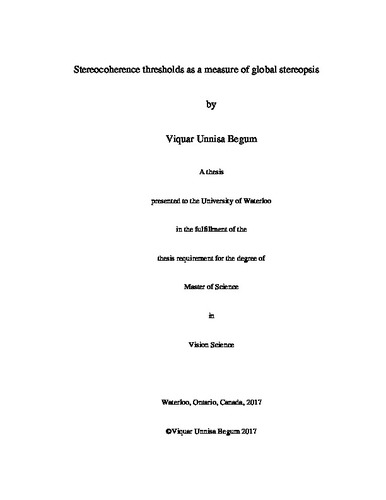| dc.contributor.author | Unnisa Begum, Viquar | |
| dc.date.accessioned | 2017-06-14 16:06:00 (GMT) | |
| dc.date.available | 2017-06-14 16:06:00 (GMT) | |
| dc.date.issued | 2017-06-14 | |
| dc.date.submitted | 2017-05-03 | |
| dc.identifier.uri | http://hdl.handle.net/10012/12009 | |
| dc.description.abstract | Purpose: The purpose of this study was to develop a robust and reliable clinical test of stereopsis that is complementary to the conventional disparity threshold tests.
Methods:
Random dot stereograms containing disparity-defined gratings were displayed on a ViewPixx® monitor using LCD shutter glasses. Participants discriminated grating orientation. Form coherence was degraded by assigning random disparities to a variable proportion of dots. The threshold proportion of signal dots required for form discrimination is called the stereocoherence threshold (stereoCT). We explored the various stimulus parameters that can affect stereoCT. StereoCT were also measured for a variety of simulated abnormal binocular vision conditions and in patients with amblyopia.
Results: StereoCT was lowest (most sensitive) for a stimulus with a spatial frequency of 1cpd ,a 5.5 arc min dot size, 183 dots/deg2 dot density and a disparity amplitude of 108 arc sec. StereoCT showed higher sensitivity and reduced variability relative to stereothresholds obtained on conventional disparity thresholds under various simulated abnormal vision conditions (interocular luminance and contrast differences, unilateral blur, and unilateral Bangerter filters). In patients with amblyopia, stereoCT improved with contrast reduction in the fellow eye relative to the amblyopic eye.
Conclusions: StereoCT testing targets the second stage of stereoscopic processing ‘global stereopsis where the local matches of stereoscopic images between two eyes are unified into a global perception of depth. Therefore, stereoCT may provide a useful measure of higher-level stereoscopic vision that is complementary to current tests, which rely on disparity thresholds. | en |
| dc.language.iso | en | en |
| dc.publisher | University of Waterloo | en |
| dc.subject | Binocular vision | en |
| dc.subject | Local and global stereopsis | en |
| dc.subject | Amblyopia | en |
| dc.title | Stereocoherence thresholds as a measure of global stereopsis | en |
| dc.type | Master Thesis | en |
| dc.pending | false | |
| uws-etd.degree.department | School of Optometry and Vision Science | en |
| uws-etd.degree.discipline | Vision Science | en |
| uws-etd.degree.grantor | University of Waterloo | en |
| uws-etd.degree | Master of Science | en |
| uws.contributor.advisor | Thompson, Benjamin | |
| uws.contributor.advisor | McCulloch, Daphne | |
| uws.contributor.affiliation1 | Faculty of Science | en |
| uws.published.city | Waterloo | en |
| uws.published.country | Canada | en |
| uws.published.province | Ontario | en |
| uws.typeOfResource | Text | en |
| uws.peerReviewStatus | Unreviewed | en |
| uws.scholarLevel | Graduate | en |

